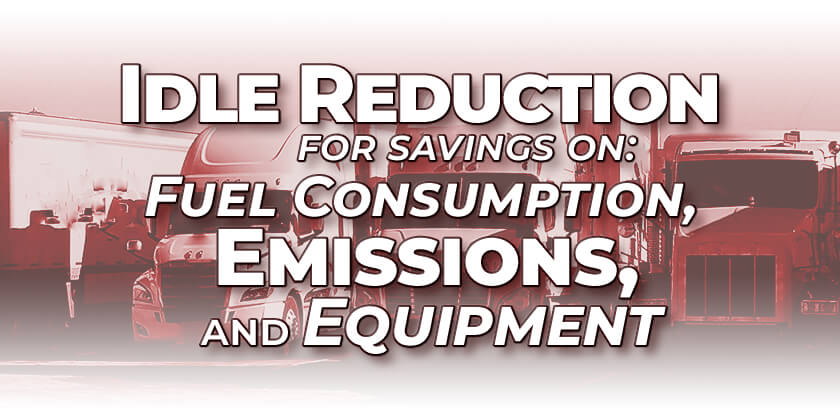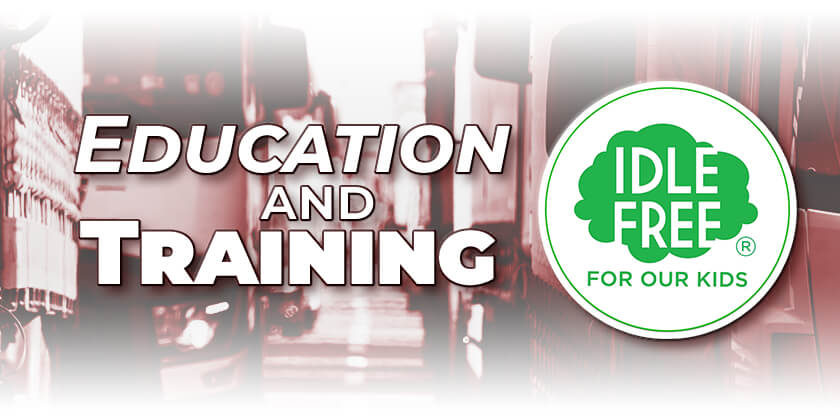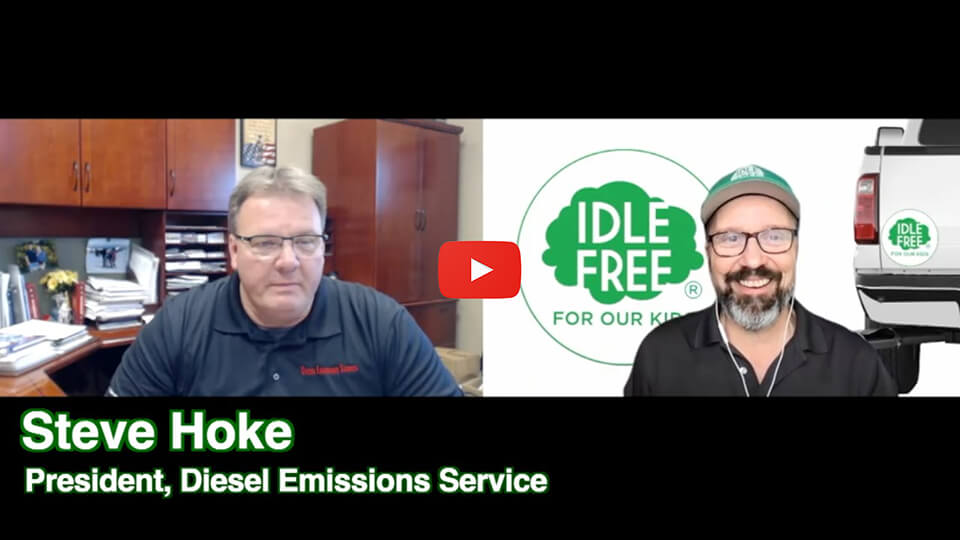The Importance of Idle Reduction for Heavy-Duty Trucking Fleets
Heavy-duty trucking fleets play a crucial role in the transportation of goods and services across the country. Despite the essential role that these fleets play, idling in trucking fleets remains a major issue, especially during winter when idling rates are highest. Idling not only increases fuel consumption and emissions but also accelerates the wear rate and service interval of critical engine systems such as the aftertreatment system.
In this blog article, we will discuss the impact of idling on heavy-duty trucking fleets, the benefits of reducing idling, and strategies that trucking fleets can implement to reduce idling.

Idle Reduction for Fuel Consumption, Emissions, and Equipment
Idling in heavy-duty trucking fleets leads to increased fuel consumption and emissions, which are detrimental to the environment and economy. Extended periods of idling cause the engine to consume fuel without propelling the vehicle, leading to increased fuel consumption and reduced fuel efficiency. Idling also produces emissions that contribute to air pollution, which has a significant impact on the environment and human health.
In addition to increased fuel consumption and emissions, idling also increases the wear rate and service interval of critical engine systems, such as the aftertreatment system. The aftertreatment system is responsible for removing harmful emissions from the engine, and idling causes the system to work harder, reducing its lifespan and increasing the frequency of service and maintenance. This leads to increased maintenance costs, reduced fuel efficiency, and decreased productivity for trucking fleets.
The cost of idling during winter can quickly add up for medium and large trucking fleets, affecting their bottom line and competitiveness in the industry. For example, idling for just five hours a day during the winter can consume over 1,000 gallons of fuel and produce over 8,000 pounds of emissions for a single truck. Multiply this by a fleet of 50 or 100 trucks, and the costs associated with idling can become significant. These costs include increased fuel consumption, increased maintenance and repair costs for critical engine systems, and increased emissions-related costs. In addition, idling during winter can also reduce driver productivity, as they are required to spend more time sitting in their trucks waiting for the engine to warm up. These costs can add up quickly, making it essential for medium and large trucking fleets to take idle reduction seriously and implement strategies to reduce idling and improve their bottom line.

The Benefits of Idle Reduction in Heavy-Duty Trucking Fleets
Reducing idling in heavy-duty trucking fleets offers numerous economic and environmental benefits. By reducing idling, trucking fleets can save on fuel costs, as well as reduce emissions, which are good for the environment and human health. In addition, reduced idling reduces the wear rate and service interval of critical engine systems, leading to increased fuel efficiency, reduced maintenance costs, and improved productivity for trucking fleets.
Less idling also helps to reduce the wear rate of critical engine systems, (especially aftertreatment) and prolongs their service life. Idling for extended periods causes engine oil to degrade, leading to increased wear on the engine and its components. Additionally, idling can also lead to the buildup of soot and other contaminants in the aftertreatment system, which can negatively affect its performance and increase the frequency of maintenance and cleaning required.
By reducing idling, trucking fleets can help to reduce the wear and tear on their engines and aftertreatment systems, leading to increased reliability, reduced maintenance costs, and improve overall vehicle performance. Additionally, reducing idling can also help to extend the service life of these systems, reducing the need for costly repairs and replacements and increasing the overall efficiency of the fleet. By taking idle reduction seriously and implementing strategies to reduce idling, trucking fleets can improve the performance, efficiency, and reliability of their vehicles, while also reducing their operating costs and emissions.

Strategies and Technologies for Reducing Idling in Winter
There are various technologies available for heavy-duty trucks that can help reduce idling and improve fuel efficiency. One such technology is the auxiliary power unit (APU), which provides power to the truck’s climate control and electrical systems while the engine is turned off. APUs are typically powered by batteries, propane, or diesel, and they can help to reduce idling by providing power to the truck’s systems without requiring the engine to be running.
Another technology is idle reduction systems, which automatically turn off the engine after a specified period of idling and restart it when it is needed. These systems can be programmed to take into account the truck’s battery state, temperature, and other factors, ensuring that the engine only runs when it is necessary.
Other technologies, such as engine and battery management systems, can also help to reduce idling by optimizing engine performance and reducing the amount of time the engine needs to be idling to maintain battery charge. By leveraging these and other technologies, trucking fleets can significantly reduce their idling times and improve their fuel efficiency, while also reducing their emissions and overall operating costs.

The Role of Education and Training in Reducing Idling
Additionally, proper training and education for truck drivers are crucial to reducing idling. For instance, the idle reduction training program offered by Idle Free for our Kids provides truck drivers with the knowledge and skills they need to reduce idling and save on fuel costs. Idle Free for our Kids is an education system designed to help reduce idling in the trucking industry, with a focus on reducing emissions and improving air quality near schools. The program provides training and education to truck drivers on the importance of reducing idling, as well as practical tips and strategies for reducing idling in their daily operations. The program also provides information and resources for trucking fleets on how to implement idle reduction technologies, such as auxiliary power units (APUs) and idle reduction systems, and how to optimize their use to reduce idling and improve fuel efficiency.
The Benefits of the Idle Free for Our Kids Education System
Studies have shown that the Idle Free for our Kids program has been effective in reducing idling in the trucking industry, particularly near schools. The program has educated thousands of truck drivers on the importance of reducing idling and provided them with the tools and knowledge to do so. By reducing idling near schools, the program has helped to improve air quality and reduce emissions, making a positive impact on the health and well-being of children and local communities. The Idle Free for our Kids education system provides a valuable resource for trucking fleets looking to reduce idling and improve their fuel efficiency and emissions. The program’s focus on educating truck drivers, combined with its support for the implementation of idle reduction technologies, has proven to be an effective tool for reducing idling and improving the overall sustainability of the trucking industry.
Despite the numerous benefits of reducing idling in heavy-duty trucking fleets, some truck drivers may resist these changes due to habit or a lack of understanding about the benefits. In some cases, drivers may feel that idling provides comfort and convenience, and they may be hesitant to adopt new technologies or change their driving habits. Additionally, some drivers may not fully understand the economic and environmental benefits of reducing idling, and they may resist changes that they perceive as intrusive or disruptive. To overcome driver resistance to idle reduction, it is essential for trucking fleets to educate and train their drivers about the benefits of reducing idling and to provide them with the tools and resources they need to adopt new technologies and practices.
This includes providing training programs, educational materials, and access to technology that makes reducing idling easier and more convenient for drivers, like the training program offered by Idle Free for our Kids.
Learn even more about idle reduction in this interview between Steve Hoke and Ron Zima of Idle Free for our Kids.
This Winter Take Idle Reduction Seriously
Reducing idling in heavy-duty trucking fleets during winter is essential for reducing fuel consumption, emissions, and equipment wear.
Trucking fleets can implement various strategies, such as the use of auxiliary power units, idle reduction systems, and proper training and education for truck drivers, to reduce idling and save on fuel costs. We encourage trucking fleets to take idle reduction seriously and to implement these strategies to improve their bottom line and contribute to a cleaner environment.
Don’t get left out in the cold – reduce idling this winter.
At Redline Emissions Products®, we hope aftertreatment articles like this one are not only informative but also practical for saving our readers time and money.
Become a REP Dealer
If you sell heavy-duty parts and want to get into the business of selling aftertreatment replacement parts and/or providing DPF cleaning to your customers, contact us today to discuss becoming one of our parts distributors.
Contact Anthony Soto, National Sales Manager for REP to find out more. Call 888-295-4670
Need Tech Support or need help troubleshooting a DPF problem? No problem! Contact REP Support at 1-888-564-4209









